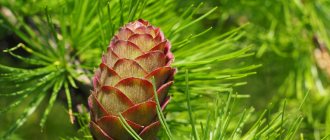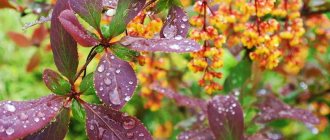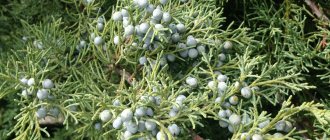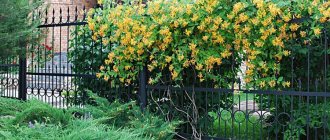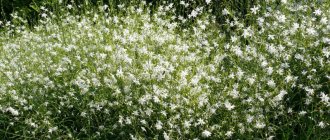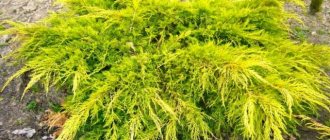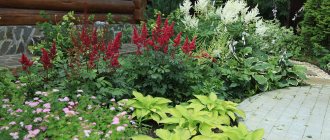Description of creeping juniper
Bushy type plant. The height is 10-40 cm, and the diameter can reach 2-2.5 m. The branches grow and spread along the ground. There is no foliage. Each branch is covered with short needles or scales. The color of the needles is pale green.
This group includes horizontal and creeping junipers. This type is used to create decorative slopes, low borders, and growing in hanging pots. The creeping shrub can easily adapt to any soil in which it is planted, even in rocky areas.
Description of the plant
A member of the Cypress family is commonly known as "heather". Juniper forests are found from the Arctic to subtropical regions. Even in the vast expanses of Africa, one form of conifer grows, called “East African juniper.” Group plantings of large trees occupy small areas mainly in the Mediterranean, Central Asia and North America, Mexico. Medium-sized specimens are found in undergrowth. Plants creeping along the ground can be seen on rocky slopes and in the mountains. The average lifespan of a heather is 400-500 years.
Juniper needles look typical for representatives of the entire family: beautiful needle-shaped, triangular, pointed towards the tips. The color is predominantly bluish-green, however, depending on the variety, it can also be golden. Juniper has spherical, slightly elongated cones. Color gray or blue. Maturation is noted one year after formation. The rhizome is powerful, taprooted.
Types of creeping juniper
There are 60 known crops that belong to creeping junipers, examples are shown in the photo below. Outwardly they are all similar. Creeping shrubs are united by a low trunk size. The structure of the needles, color, and size may differ.
Andorra Compacta
The bush is densely branched. The maximum height of the bush is 40 cm, width – 2 m. The color of the shoots is brown-green. The bark is brown. The surface of young branches is smooth, while older ones have cracks. The type of needles is scaly or needle-shaped. Its structure is soft and pleasant to the touch. The needles are not wide and tightly pressed to the branches. Creeping juniper is green in summer and turns purple in winter.

Blue Chip
In 1945, the Danes developed a creeping variety. Skeletal shoots are rare. The shape of the bush resembles a five-pointed star. The ends of the branches tend vertically upward. This form of juniper has a raised middle. The needles are mostly needle-shaped, sometimes scaly. The color is grayish blue. There are thorns on the shoots. This ground-blooded shrub reacts negatively to excess moisture. Planting in sunny areas is recommended.

Limeglow
Creeping juniper with yellow needles. The bush is compact. The shape of the crown resembles a vase. The needles are feathery. The color changes throughout the season, becoming orange in winter. It grows slowly. The fruits are rare. The variety does not tolerate excessively wet soil. Photophilous. Frost-resistant. The shrub is resistant to diseases and pests.
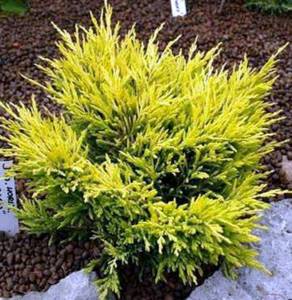
Prince of Wales
Combining the top layers with the bottom layers gives a deep green color. The height of the creeping shrub is 30 cm, diameter is 2.5 m. The plant is characterized by slow growth. The form is creeping. The bark is red-gray. The needles are scaly, thick, rich green in color. Reacts calmly to frost and sudden temperature changes. They are mainly planted in open areas for greater decorative effect.
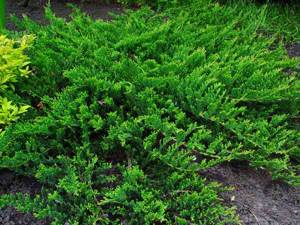
Wintering juniper in the country

Autumn
In autumn, this plant must begin to be prepared for wintering. To do this, juniper is pruned for sanitary purposes, and injured, dried out branches and shoots growing in the wrong direction are cut off. Then the plant and the surface of the tree trunk are treated with a solution of Bordeaux mixture (1%) in order to prevent various diseases and harmful insects.
Winter
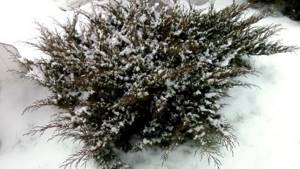
Juniper is frost-resistant. In areas with mild winters, it does not need to be covered for the winter, but the branches should be tied together with twine. It is recommended to cover young plants with spruce branches for the winter.
Useful articles from the “Trees and Shrubs” section:
Useful articles for gardeners:
- Planting corn in 2021: sowing dates, cultivation and care
- Work in the garden and vegetable garden in April: what needs to be done?
- When to sow basil seedlings in 2021: sowing dates and care
- Planting broccoli in 2021: timing, cultivation and care
- Kalanchoe growing and care at home
- When to harvest radishes for storage in 2021: harvest dates
- Harvesting beans in 2021: timing, how to store correctly
- Favorable days for canning in 2021: calendar of winter preparations by month
- When to harvest cabbage for storage in 2021: harvesting dates
- When to store onions in 2021: timing
Creeping juniper in landscape design
In landscape design, creeping juniper is included in decorative single plantings or acts as an integral part in group compositions. Evergreen shrubs look elegant against the background of snow. Low-growing varieties are planted on rocky hills, rock gardens, to stabilize the slopes. Creeping plants grow within 3-4 years, visually creating the appearance of a green carpet.
Creeping juniper combines beautifully with conifers. Various shades and textures are appreciated by designers of street compositions.
Varieties
Several varieties from this group are used in landscape design. After reading their name and description, you can choose the most suitable variety for landscaping your own plot.
Andorra Compact
A dwarf creeping bush, which reaches 40 cm in height, has a symmetrical crown. It grows very slowly - annual growth is 1-2 cm.
The needles are green with an ashen tint; closer to winter they take on a lilac tone.
Blue Chip
A low-growing shrub up to 30 cm high, with a wide dense crown - a circumference of up to 1.5 m.
Prickly juniper has tough, bluish-blue needles, which take on a brownish, lilac or violet hue during the cold season.
The plant is resistant to gas pollution, so it is readily used to decorate park areas, alleys, and industrial landscapes.
Variegata
Tall bush - up to 50 cm, with a cushion-shaped crown with a circumference of about 3 m.
Fast-growing conifers of this variety can increase in diameter by 30 cm and in height up to 12 cm in a year. The needles are soft, scaly, blue-green in color.
Gray

Juniper will decorate your area
A creeping plant with a cushion-shaped crown and numerous shoots, densely covered with scaly, blue needles with a steel tint. Height reaches 30 cm.
Planting and caring for creeping juniper
Garden crops require standard care. It takes root quickly. Hardy. Grows easily in city conditions. Varieties of creeping juniper give a small increase per year, about 5-7 cm. In an environment with optimal conditions, the evergreen shrub has a life expectancy of 600 years.
Preparation of seedlings and planting area
It is preferable to buy creeping juniper planting material in containers (see the photo). Then landing is possible at any time. Creeping bushes at the age of 2-3 years are suitable for planting in open ground. The young plant should not show signs of rot or fungal diseases. Roots that are in a closed form adapt faster to space and grow. If there are dry or damaged shoots, they should be trimmed. Trim the side branches and the top to ½ the length of the growth.
The choice of soil depends on the variety of creeping juniper. Basically, the shrub grows well in sandy, loamy, alkaline soils. Prefers a large predominance of peat in the soil. Heavy soils are not suitable for cultivation.
For rapid growth and rapid development, you can use a substrate: coniferous soil, peat, sand. All components will be required in equal proportions. The depressions are prepared 23 days in advance or on the day of planting.
How to plant creeping juniper
Creeping juniper is usually planted in spring or mid-autumn. When planting a plant in another period, slow development and poor survival are observed. In order not to damage the rhizome in the process, the creeping bush is planted with a lump of earth.
- Dig a hole. The dimensions of the hole should be 2-3 times larger than the root system.
- The depth is provided for at least 70 cm.
- Drainage made of gravel or crushed stone is laid at the bottom. Layer thickness 15-20 cm.
- A creeping juniper sapling is placed in the center of the recess and sprinkled with earth.
- Water generously.
- Carry out mulching around the trunk circle.
When planting creeping shrubs, you should keep your distance. The distance between creeping bushes should be at least 1 m. Otherwise, one plant will overlap another, creating shadow.

Transfer
When choosing a good site for a coniferous shrub, you should keep in mind that an adult garden plant does not tolerate a change of location. Therefore, creeping juniper is planted on the most successful site, in the gardener’s opinion. Otherwise, the plant will begin to hurt, stop growing for a long time, and yellowing may occur on some branches. A transplanted creeping bush may not survive the winter and wither away.
Attention! The principle of transplanting creeping juniper is similar to the planting process.
Watering and fertilizing
Young growth is watered regularly, but not abundantly. During periods of prolonged absence of rain, water the bush once every 7 days. Creeping juniper is a drought-resistant plant, so water procedures are carried out three times a month. In hot weather, the procedure is performed early in the morning or in the evening. The bushes are also sprayed.
Fertilize creeping juniper in the spring season. Use nitroammophoska in the amount of 20 g per 1 sq. m. It is possible to use other complex preparations for feeding conifers. In September, the fast-growing creeping juniper bush is fed with fertilizers containing phosphorus and potassium.
Mulching and loosening
The tree trunk circle should be regularly cleared of weeds. Mulching will help solve this problem. The procedure helps retain moisture in the soil. Natural material for mulch: pine chips, pine needles, gravel. They will have to be laid on black geotextiles. Minimum layer 5 cm.
After watering, a dense crust forms on the ground, which does not allow the root system of the creeping plant to “breathe.” The loosening procedure is necessary to saturate the soil with oxygen and eliminate weeds. Use a hoe to lift the top layer of soil shallowly so as not to harm the roots.
Preparing creeping juniper for winter
For the winter, cover with creeping junipers that are no more than 4 years old. They choose burlap and spruce branches for this. In cold climates, overgrown bushes are also protected from frost by tying them with twine. This will strengthen the crown and prevent it from breaking under the weight of snow.
How and when to plant in open ground?
The question of how and when to plant juniper in open ground is probably asked by many summer residents, because the life of the plant depends on the correct actions. To do everything correctly, you must follow the recommendations given in our article.
For planting, you need to select high-quality groundcover juniper seedlings no more than three years old. There should be no visible damage or stains on them, and if you notice signs of disease on a young plant, it is better not to buy it. Also, the roots of the seedling must be completely in the ground and sufficiently moist. If you notice dry roots, you need to cut them off or not buy such a plant at all.
Boarding time
The best time to plant and grow horizontal juniper is mid-April or early May. Spring seedlings will have time to take root before the onset of cold weather and will survive the winter well. The roots will go deep into the ground, and then the plant will not be afraid of frost. If you purchase a seedling with closed roots, then you can plant it in open ground in the fall, preferably in October.
Among other things, the time of planting this crop also depends on the region. For example, in Siberia, a plant should be planted only at the end of spring, since cold weather in this region sets in much earlier, and when planting juniper in the fall, the plant will not have time to take root.
Basic Rules
Knowing the basic rules for planting creeping juniper, you can be sure that you will plant the plant correctly, and it will serve you for many years, decorating your site.
Planting seedlings in open ground has a certain order. First you need to choose the right area for planting and determine the condition of the soil. The plant loves sunny areas and cannot grow where it is quite crowded, so placing it in close proximity to other crops will be the wrong decision.
Having selected a site for planting a crop, follow the following recommendations.
- The first step is to dig a planting hole. Its size directly depends on the size of the root system of the seedling. If the plant has small roots, then a hole with dimensions of 50 centimeters in depth and the same in radius will be sufficient. It is advisable to dig a hole two weeks before planting the plant. A drainage system of stones and sand must be laid at the bottom to protect the juniper roots from groundwater, otherwise the root system may begin to rot. The thickness of the drainage layer must be at least fifteen centimeters.
- Next, in the planting hole you need to lay out a layer of soil recharge, which should consist of sand, peat and clay in equal parts.
- Place the juniper seedling in the planting hole so that the root collar is at least ten centimeters above the soil layer. Then fill the plant and press the soil with your palm.
- The first time you need to thoroughly water the planted creeping juniper, fill it with ten liters of water, and then mulch the soil around the plant with sawdust.
When planting several shrubs, keep in mind the fact that they must be planted at a distance of two meters from each other. Plants do not like it when something interferes with their growth, so if your juniper variety is large-growing, do not allow the branches of the bushes to intersect.
After carefully reading our tips, you will learn how to properly plant horizontal juniper at home. But when you do this, you will need to provide the plant with quality care. Read more about this in the next section.
Pruning creeping juniper
Pruning is a mandatory method of caring for juniper, which also has a decorative function.

Is it possible to prune creeping juniper?
It is possible and even necessary to prune creeping juniper. If you do not trim the bush, then in the 3rd year after planting the crown will grow and the bush will take on an unkempt appearance. The timing of the procedure is not strict. The best time will be April and September. The plant loves pruning, so it can be done throughout the year, with the exception of the period of active growth. It is also not recommended to prune shoots in frosty weather.
Trim the creeping low-growing juniper twice a year or as needed. There are 2 types of pruning. Sanitary cutting - removal of dry, damaged, frozen shoots. Thus, monitor the density of the bush. The second type is formative pruning. It is carried out at the discretion of the gardener; if the natural form of an evergreen creeping crop is not suitable, then the juniper is given different geometric shapes.
How to prune creeping juniper
Shrub pruning algorithm:
- Bare branches, not covered with green needles and without dormant buds, are removed completely from the stem.
- In one procedure, you cannot trim more than 1/3 of all greenery. Otherwise, slow-growing creeping junipers will have a difficult time recovering.
- Wood cuts should not be made crosswise, as they take longer to heal and do not look aesthetically pleasing.
- Garden cutting tools must be sharp and disinfected.
- Most varieties of creeping junipers contain toxic substances. To protect your hands while pruning, you should use gloves.
- Open cuts on bushes are treated with garden varnish.
- To make the crown thicker, you need to cut off 1/3 of the current year's growth.
- At the end of the procedure, creeping varieties are fed with useful substances and also treated with a fungicide solution.
Rules for cultivating juniper
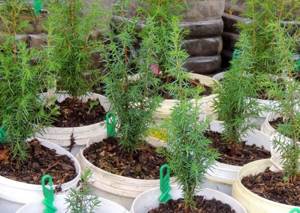
In order for the ephedra to become a permanent “inhabitant” in a cozy garden and delight you with its crown throughout the year, it is necessary to follow agricultural cultivation techniques. The latter includes a number of points:
- selection of the appropriate site, depending on the type of juniper and variety;
- compliance with technology and planting deadlines,
- implementation of care measures, including crown formation and protection from harmful organisms and frost;
- timely transplantation, rejuvenation and reproduction.
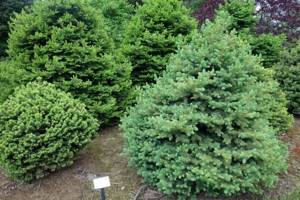
How to propagate creeping juniper
The propagation process is possible in 3 ways: layering, seeds and cuttings. The first two methods are used extremely rarely, especially the seed method. Only breeders can grow an evergreen creeping shrub from seed, because seedlings are expected to appear three years after planting.
The main method of propagation of creeping juniper is cuttings. Parts of the shoots are cut from a bush that is at least 8-10 years old. The length of the cutting is 10-15 cm. The needles are removed from the shoot 5 cm from the cut, but the bark must be left. For rapid root formation, a branch of creeping juniper is dipped into a stimulating solution for 30 minutes. Then the cuttings are planted at a slight slope into the ground. Cover with plastic wrap and place in a dark place. It is important to observe the following microclimate parameters:
- temperature + 19-20 °C;
- moderate substrate humidity;
- constant spraying with warm water;
- diffuse lighting.
After 30-45 days, roots appear. At the age of two or three years, creeping juniper can be planted in the ground.
Juniper propagation
Various methods can be used to propagate the plant. With the exception of growing from seeds, they can be used even by novice gardeners without experience.
The seed method involves collecting plant seeds, which are first disinfected in a permanganate solution, and then placed for 2 hours in liquid humic fertilizer, which serves as a biostimulator of growth and strengthens the immunity of the crop. In May, when the weather is warm, the seeds are sown in open ground and before germination, the soil is moistened, preventing it from drying out.
Heather can be propagated using cuttings.
- To do this, cut branches 12 cm long with a “heel”, clear the lower part of the needles and soak in a solution of a stimulator for root development for 24 hours.
- The soil for cuttings should consist of peat and sand; containers are filled with it, where the seedlings are placed to a depth of 3 cm.
- Then you need to water the plant and cover it with film. The juniper will remain in greenhouse conditions for 1.5 months; it is advisable that the room temperature be maintained at +21-22 degrees.
- To prevent the appearance of mold, you need to ventilate the heather every 5 hours, lifting the film.
- After rooting, 60 days later, the branches are transplanted into separate containers. Three-year-old bushes can be planted in open soil.
A simple method of propagation is by layering. The lowest branches of the plant, closest to the ground, are suitable for this. An oblique cut is made on the branch, then the shoot is bent to the soil and, having secured, it is covered. After the branch produces a root, it is cut off with garden shears and transplanted to another place. The procedure can be carried out in the spring and until mid-July.
You can do it easier and purchase a young plant for planting at a gardening center. All that remains is to plant it correctly.
Diseases and pests of creeping juniper
If you carry out preventive care for creeping juniper, then the likelihood of infection by infectious diseases is low. Meanwhile, the evergreen shrub is afraid of gray mold and fungal rust. You can cope with such ailments with systemic fungicides.
Harmful insects are rarely found on creeping juniper. However, you can protect the plant from aphids, scale insects or spider mites using insecticides: “Aktara”, “Aktellik”. If the treatment is carried out in a timely manner, the bush can be saved from complete infection.
Landscape use
Juniper is one of the most popular crops in the design of unusual and original garden compositions.
The rapidly growing plant densely covers any surface, making it rich, bright, and is not afraid of gas contamination.
- It is used in single and group plantings, planted in a flower bed, near a gazebo, or terrace;
- Grown in combination with other medium-sized and tall conifers;
- Placed in the center of a living composition surrounded by perennial bright-blooming roses and hydrangeas;
- A horizontal bush looks beautiful in a mixborder with mosses and heather;
- Tolerates the proximity of decorative deciduous flowers and cereals well.
Juniper horizontal in garden design.
Juniper horizontal Blue Chip care / Juniper planting and care / conifers
Juniper horizontal. How to reproduce?!
Heather varieties for the Urals
For cultivation in the Ural climate, different varieties of this coniferous crop are suitable, the general characteristics of which are high winter hardiness, immunity to drought and ease of care.
Columnar Chinese heather "Blue Arrow" is a large tree up to 5 m high and with a crown diameter of 1 m. The plant has beautiful blue needles, the branches grow upward, and the crop is highly frost-resistant. Area of application: hedges.
Blue scaly juniper “Meyeri” has a height of 3 m, the volume of the above-ground part is 2 m. The tree is not afraid of low temperatures, prefers loose and light soil.
The bud cover shrub "Arcadia" is a plant that is not susceptible to polluted air and tolerates frost well. It has green needles of a light shade. With a crown diameter of 2.5 m, the height of “Arcadia” is only 0.5 m. Use is mainly associated with the creation of tightly closed group plantings as a border.
The tall juniper "Skyrocket" has a narrow crown and a height of 10 m. This winter-hardy species can be cut. The tree's needles are blue.
Dwarf heather - "Glauka" grows horizontally in relation to the surface of the earth. This is a beautiful ornamental plant that can be used in landscape design.

